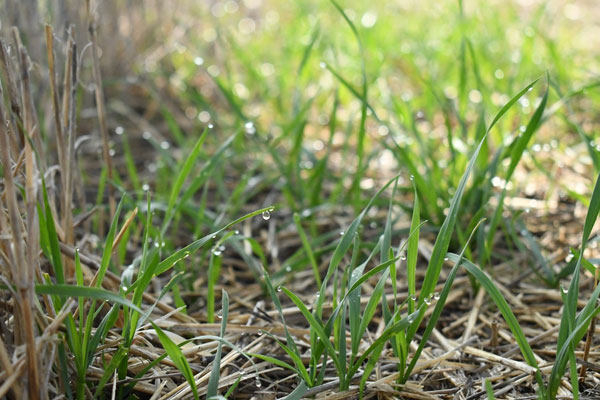The wet weather has resulted in the emergence of volunteer wheat over the last few weeks in some parts of Kansas (Figure 1). There have been questions about the risk that this wheat poses for wheat streak mosaic virus (WSMV) to the surrounding emerged crop (see Figure 2 for a photo of WSMV symptoms). Here we walk through some considerations, as well as termination strategies.

Figure 1. Volunteer wheat that has emerged in wheat residue. Photo by Sarah Lancaster, K-State Research and Extension.
What is the green bridge?
As a reminder, the term ”green bridge” is used to describe the volunteer wheat that emerges in the summer after wheat harvest. That is because at harvest time wheat curl mites are abandoning mature wheat in search of green tissue to survive on. If there is volunteer wheat around, and that wheat is not terminated, the curl mites can hitch a ride on that wheat until the crop emerges after planting in the fall. In the fall, those mites will migrate from volunteer (and other weedy hosts) to the new wheat crop. This cycle completes the green bridge
Volunteer wheat that emerges very close to planting, or in the spring, is technically not considered part of the ‘green bridge’. This is because the fall wheat crop has already emerged on a much higher area than volunteer wheat. The fall crop itself can serve as a sufficient host for curl mites that have survived the summer.

Figure 2. Typical symptoms of wheat streak mosaic virus. Photo by Kelsey Andersen Onofre, K-State Research and Extension.
Is spring-emerged volunteer wheat as risky as summer-emerged volunteer wheat for WSMV spread?
No. For the reasons we mentioned above, spring-emerged volunteer wheat is less risky than summer-emerged volunteer wheat, because it essentially acts as a (much smaller) neighboring wheat crop. That being said, if curl mites have survived locally, they can still reproduce on this volunteer wheat, just as they would in wheat production fields. If WSMV is a concern, terminating this volunteer crop can avoid successive cycles of mite reproduction. Volunteer from fields with high WSMV levels in 2020 would be of highest concern. When making the decision to terminate this spring-emerged volunteer, the desire to control curl mite populations should be balanced with other agronomic factors.
Are there other agronomic considerations for volunteer wheat that has emerged in the spring?
Potential uses:
- Depending on the amount of volunteer wheat emerged in the spring, it can serve as a potential grazing option for livestock, as young wheat is a very high quality forage.
- Volunteer wheat that emerged in the spring can be used as a cover crop to help reduce wind or water erosion and increase carbon (organic matter) returning to the soils, if it is terminated prior to a summer crop similar to cereal rye or spring oats.
Potential risks:
- Volunteer wheat may complicate the management of other weed species that may also be present.
- Volunteer wheat may consume use water that could be conserved for a summer crop.
What are the best termination strategies for spring-emerged volunteer, prior to summer crop planting?
Glyphosate is an inexpensive option to control volunteer winter wheat that will have little to no impact on the following summer crop. Applications of a formulation that contains 4.5 pounds per gallon at a rate of 24 to 44 fl oz/A will be effective, assuming weather conditions are appropriate. No herbicides will work well when temperatures are below 60°F during the day and/or 40°F overnight.
Other herbicides that will control volunteer winter wheat include Group 1 herbicides such as Assure II (fluazifop) or Select (clethodim). Group 1 herbicides do have rotation restrictions when applied before corn or grain sorghum. Residual herbicides such as atrazine, Canopy (chlorimuron + metribuzin), or Sharpen (saflufenacil) can also be included. However, these products also have rotation restrictions to various crops. It is important to consult product labels to determine application rates and rotation restrictions for your specific situation.
What should I do if I think I have WSMV?
Contact your local K-State Extension Office. They will work with you to send photos of the problem (close-up, whole plant, field shot) and plant tissue samples to the K-State Plant Disease Diagnostic Lab.
Use this link for the sample submission form:
https://www.plantpath.k-state.edu/extension/diagnostic-lab/documents/DiseaseLabChecksheet.pdf
Here are guidelines that can help get a good sample to the lab:
- Fill out the accompanying Plant Diagnostic Lab Form (PDF) as completely as possible.
- Send a plentiful amount of fresh plant material (including roots). It is best to include the entire plant when possible. Shake off most of the soil.
- Send a plant sample that is characteristic of the problem (exhibits a range of symptoms).
- Dig (do not pull) up the plant, so the roots remain intact.
- Do not add water or wet paper towels to the sample!
- Seal the plant material in an appropriately sized plastic bag and pack in a crush-proof container.
- Put the accompanying information sheet in a separate plastic bag to keep it dry.
- Note that samples that arrive prior to Thursday will be completed the week they arrive, while those that arrive after Thursday will be placed in the virus testing panel for the following Thursday.
Shipping address:
K-State Plant Disease Diagnostic Lab
4032 Throckmorton PSC
1712 Claflin Road
Manhattan, KS 66506
Contact information for K-State Plant Disease Diagnostic Lab:
clinic@ksu.edu
785-532-1383
Kelsey Andersen Onofre, Extension Wheat Pathologist
andersenk@ksu.edu
Sarah Lancaster, Extension Weed Science Specialist
slancaster@ksu.edu
Romulo Lollato, Extension Wheat and Forages Specialist
lollato@ksu.edu